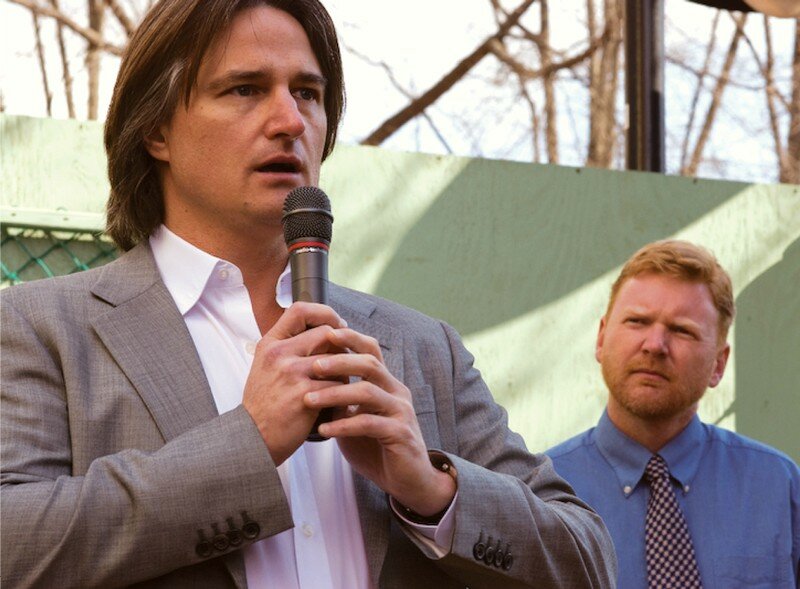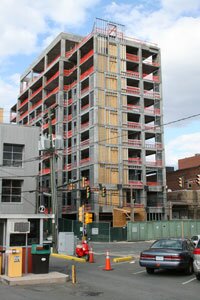Now what? As the Landmark lies dormant, what's next?

The Big Sleep: Workers began boarding up the Landmark Hotel in April, which the city is now treating as an "abandoned structure."
PHOTO BY DAVE MCNAIR
"We will treat it as we do any abandoned structure and keep an eye on it for any code issues," Charlottesville planning chief Jim Tolbert said when asked if the city had any safety concerns about the unfinished Landmark hotel. "We've also asked that it be boarded up."
Indeed, just like an abandoned building, workers began boarding up the side of the hotel with plywood in late March leaving many to wonder what will happen to the building if it remains abandoned for years.
Workers were spotted at the Landmark off and on several weeks ago, but a Clancy & Theys Construction Company official tells the Hook it was only to secure the site. Indeed, as Tolbert confirms, making sure the unfinished tower is made safe before it's abandoned is Clancy & Theys' responsibility.
"We've met with the City of Charlottesville building officials on the procedures to secure the site and are currently implementing these procedures," Clancy & Theys vice president James Tollenaere said in early April, adding that all leased equipment has been removed from the site, including the large crane and the scaffolding along the side walk on Second Street, while safety barricades, handrails, and fire safety equipment, will remain in place.
Now that the Landmark's owner, Halsey Minor, and its developer, Lee Danielson, are locked in a legal battle over who is at fault in running up the cost of the hotel from an initial budget of around $31 million to as much as $50 million, according to Minor's suit against Danielson, and with the property mired in a bank default, the unfinished, 92,000-square-foot concrete shell could remain a fixture on the Mall for months, if not years.
Whatever happens to the incomplete structure will have to go through Stuart Simon. The Richmond attorney was recently named by lender Silverton Bank as the hotel's substitute trustee. This means he's ultimately the one who might hand it to a receiver or stand on the courthouse steps for an auction if Silverton forecloses.
"I haven't a clue what's going to happen with it," says Simon. "I have no instructions from the bank. I'm just the person who's holding title until the owner holds title or goes into default."
Meanwhile, what's going to happen long-term to the shell, or Tyvek Tower (as some wags like to call it)?
"It depends on what 'long term' turns out to be," says UVA engineering professor Thomas Baber. "If we are talking about several years, the situation gets more sticky, since the structure could be subject to freeze-thaw cycles that could, over time, damage the structure, at least on the surface."
While Tollenaere says Clancy & Theys will secure the site, it appears the company's responsibilities will end there. When asked if the company had a plan to address Baber's concerns about freeze-thaw cycles, Tollenaere declined to comment, saying any further questions about the Landmark's design, construction, and development would have to be addressed by its owner.
Minor, however, has been repeatedly unavailable for comment concerning any long or short-term plans for the project.
If the building sits for an unusually long time, say, several years, Baber suggests that the botanical garden that some folks would like to see built in McIntire Park might grow organically on the Mall.
"The other thing that could, over several years, start to introduce damage is plant life," says Baber. " There are plants that can survive almost anywhere, and their roots can start to do damage. Of course, this isn't a short term scenario, and a year or two wouldn't really do much... other than creating an eyesore for the Mall."
If not a hotel, then what?
With Minor suing Silverton Bank, and with the prospect of Silverton foreclosing on the property seeming increasingly likely, the question has arisen of what a different owner could do with the half-finished structure with shorter-than-usual ceiling heights [see sidebar].
The most obvious path would be to finish it as a hotel, which is precisely what the Landmark's original developer Lee Danielson would like to do.
"It's still a great project," says Danielson. "Before the financial trouble, we were on budget and ahead of schedule. It could still be a great hotel."
Still, according to George Overstreet, a commercial real estate professor at the University of Virginia's McIntire School of Commerce, if the project were to ever become profitable as a hotel, any new owner would have to cut way back on the hotel's platinum-level budget.
"If the budget's gotten up to $50 million like the bank claims," says Overstreet, "then it starts to look really shaky, particularly in this economy. Even at the original $30 million budget, it looks shaky. At $20 million, it starts to look more probable."
Regardless of the budget, Overstreet says the new owner may not have a choice but to make it a hotel.
"I've heard some people talking about turning them into high-end condos," says Overstreet, "but if you have ceilings as low as they've got, you're limited in the potential for high-end condos."
According to real estate developer Richard Spurzem of Neighborhood Properties, the building's viability as an apartment complex depends on how far construction progressed before work stopped.
"If it's the kind of concrete where they've got tension cables running through it," says Spurzem, "then you really can't reconfigure the building, because you can't start doing things like moving bathrooms to places where they weren't intended to be."
However, architect Bill Atwood says that low ceilings don't rule out the possibility for the building to become middle-income housing.
"You'd have to make them into one-bedroom studios," says Atwood, "but there is absolutely a market for workforce housing in this town. Instead of working people having to commute from Waynesboro as they're starting to do now, you could have them walk to work. You could even put a little retail in where the lobby is supposed to go."
Still, Atwood warns that those hoping to make such a project might be disappointed.
"You'd have to start a non-profit, and get the major players in town to donate to it," says Atwood, "but this would be a legacy project for Charlottesville. This would get national recognition, and it would be an investment in the future of Charlottesville."
See you in court: Landmark's future tied up in lawsuits
by

If Internet entrepreneur owner Halsey Minor (left) is looking for a lifeline of capital to save his Landmark Hotel, it won't come from Mayor Dave Norris (right). Says the mayor, "I can't imagine how we justify putting money into a luxury boutique hotel when we're putting off capital expenditures."
FILE PHOTO BY JAY KUHLMANN
One clear spring day last year, three giants of Charlottesville donned hard hats, took up golden shovels, smiled for the camera, and broke ground on a project that was to be the next great addition to the Downtown Mall. It was March 11, 2008, when Internet entrepreneur and would-be hotel owner Halsey Minor, developer Lee Danielson, and Charlottesville Mayor Dave Norris heralded the arrival of the Landmark as a great day for Charlottesville business.
"It will be a catalyst for the continuing growth of downtown Charlottesville," said Minor.
"You can't imagine how it feels to be starting this," said Danielson. "I was wondering if it was ever going to happen."
"Anytime you bring something like this downtown," said Norris, "it can only help."
Now, it appears, that as happily as the story began only one year ago, it will end not with this trio smiling with giant scissors in hand, ready to cut the ribbon on a 100-room luxury hotel. Instead, Minor has fired Danielson, lawsuits are flying, and the Landmark Hotel, originally set to open this Fourth of July, is instead deserted and unfinished.
After months of public wrangling over its financing that's led to a three-month-long work stoppage on the Landmark Hotel, officials with the hotel's Atlanta-based lender Silverton Bank, have now officially thrown a gauntlet at the feet of Minor. The bank has filed suit against Minor alleging that he has missed $10.5 million in payments on the $23.7 million construction loan.
The latest suit means that, combined with collection actions already filed by Merrill Lynch as well as the Christie's and Sotheby's auction houses, Minor could be on the hook for nearly $60 million in alleged debts.
In November, it was Minor who claimed Silverton was ruining the deal. "Halsey Minor paid," said Minor. "The bank didn't pay. They flat-out did not pay."
The bank's suit, filed February 24 in Fulton County, Georgia, alleges that Minor has committed seven moves that constitute default including firing the developer without the bank's consent and making "misleading and incorrect" statements in loan documents.
Minor has not returned the Hook's calls for comment. However, in February, in filing a lawsuit of his own against Silverton and Danielson, Minor called the Landmark "an unviable project" and laid much of the blame in the opposite direction.
Minor alleges that the bank and Danielson "colluded" in presenting him a bogus construction budget. For instance, Minor alleges that Danielson intentionally hid $5.2 million in expenses for such "ordinary and customary" costs as elevators, fire protection, and plumbing fixtures plus the costs of the main-floor restaurant and the addition of a penthouse-level lounge.
Danielson has blasted the suit's claims, calling them "preposterous" and asserting that he has paperwork to demonstrate Minor's foreknowledge of the charges.
In its default suit against Minor, Silverton agrees that cost has exceeded budget, but the bank directs blame at the owner. Silverton also alleges that Minor has suffered such adverse changes to his financial position that he's unable to complete the hotel. The bank also claims that it wasn't until February 19, just after a work stoppage, that Minor informed the bank that the project budget had exploded from approximately $30 million to approximately $50 million.
According to George Overstreet, a professor at UVA's McIntire School of Commerce, a project in default of its loan has hit quite a roadblock.
"Minor will either have to pay up," says Overstreet, "or the bank will have to foreclose."
"With the cost overrun of $20 million," continues Overstreet, "his $7 million in equity is now a smaller percentage of the total cost. So in addition to this $10.5 million he's supposed to owe them, he'd have to cough up more in equity."
The City of Charlottesville has some expertise on that front. In 1985, beginning what some critics have characterized as a series of missteps, it started pumping over $11 million in taxpayer funds into what would become the Omni Hotel.
As much as he hates the "eyesore" of the unfinished Landmark shell, current mayor Dave Norris doesn't see another City bailout of any private enterprise, much less another hotel.
"I can't imagine," says Norris, "how we justify putting money into a luxury boutique hotel when we're putting off capital expenditures."
So who will ultimately own the Landmark? The professor says it likely won't be Minor.
"Unless he pays up, I doubt Minor will be the owner," says Overstreet. "If the bank forecloses, they'll try to sell it. But in this economy, who's going to want a $50 million hotel?"
Read between the liens: Contractors say project hasn't paid
by

Before work halted on the Landmark Hotel, did Halsey Minor, seen here at the March 2008 groundbreaking, stop paying his workers? Whether it's Minor's fault or his lender's, seven contractors have unpaid bills.
FILE PHOTO BY JAY KUHLMANN
If a visitor to Charlottesville were to come upon the construction site for the half-finished Landmark Hotel, only to find it bereft of any actual construction activity, it might seem a curious, almost Twilight Zone-esque sight. But if that visitor were to wander a little further, up to Charlottesville Circuit Court, walk into the clerk's office, and do a few searches on its computer system, it wouldn't take long to find out that there is no other-worldly phenomenon behind the eerie silence. Rather, it boils down to the very tangible reality of dollars and cents.
Since work stopped on the Landmark in February, seven contractors have filed mechanic's liens against the Landmark in Circuit Court, in an effort to compel Landmark owner Halsey Minor to settle allegedly unpaid bills. In all, they seek a combined sum of more than $1 million.
The bulk of that alleged debt is claimed by two Lynchburg-based companies. HVAC firm Southern Air claims it is owed $654,172 for its materials and labor on the project, and BAT Masonry alleges it is owed another $124,005. Still, Southern Air CEO Ronald Kidd says he is hopeful that not only will he see that money, but that he will be part of the team that completes the Landmark Hotel.
"I'd rather not discuss it right now," Kidd told the Hook, "but we absolutely intend to finish the job."
Other liens on the project include one valued at nearly $137,000 from Baltimore-based interior design firm R.D. Jones & Associates Inc, and another from structural engineers Tadjer Cohen Edelson Associates from the Washington, D.C. area claiming nearly $52,000 in owed compensation.
Representatives from these and three other subcontractors had either not returned the Hook's calls or declined to comment, and Minor has not returned the Hook's calls, but ousted Landmark developer Lee Danielson has said this is likely just the first batch of these liens.
"I know people on this project who are owed everything from $3,000 to more than $300,000," says Danielson. "That's the real shame of this. If you figure everyone working on this project has an average of one spouse and one child depending on their income, there are at least 1,000 people who have been affected by Halsey Minor not paying them."
Danielson has some history of his own with liens and suits. When he and then-business partner Colin Rolph teamed to build the Charlottesville Ice Park and Downtown Regal Cinema on the Downtown Mall's west end in 1996, contractors filed a combined $2.02 million in mechanics liens on the projects, more than double what Minor now allegedly owes his workers on the Landmark Hotel. Danielson and Rolph would eventually pay off the majority of those debts before splitting amid public bickering over money and the future of the Ice Park in 2003.
More recently, Charlottesville saw liens of this magnitude in October, when more than a dozen local contractors filed for 129 liens on projects owned by Church Hill Homes. When that company began to fail amid a declining economy and a fast-deflating real estate market, the hundreds of thousands of dollars owed to its subcontractors led to layoffs, with some companies slashing as much as half of their work forces.
In documents obtained by the Hook, 34 different subcontractors were working on the Landmark project at the time of the work stoppage, including five companies owned and operated in the Charlottesville area.
Fortunately for local business, of the local contractors the Hook contacted, all reported they were paid in full.
"We were lucky," says Chris Kean of Lincoln Surveyors. "Most of the work we were supposed to do was on the foundation, and that's done. We got paid before the stoppage."
Still, Kean says, he was expecting some business at the end of the project, too.
"We were supposed to do an as-built survey," says Kean. "Obviously, we're not going to get back for a while."
Mark Glover, COO of Mountain Lumber Company in Ruckersville, says that while his company was paid for its preliminary planning to do the floors for the Landmark, it would have been nice to have the business for the big project.
"It was a fairly good-sized order," says Glover. "In this economy, we've managed to retain our personnel, but we've had to cut back in other areas."
What remains to be seen is when exactly these contractors can expect to get back to work.
"Your guess is as good as mine," says Kean. "I just know what I read in the paper."
One contractor who began working for Minor on the Landmark project beginning just after last March's groundbreaking spoke with the Hook on the condition of anonymity, for fear she would follow Danielson as the target of another lawsuit from Minor.
"I saw the writing on the wall in the second week of November," she says, "when we weren't getting paid, and then suddenly about $1 million came through three weeks late in late December after much teeth pulling."
About two weeks later was when the word came down from her boss that she would soon be out of work.
"I got laid off on January 9," she says. "I was told that the reason was that the building had gone ahead of design. In layman's terms, that means the architects and designers hadn't been paid, and they weren't going to hand over their work until they were paid."
In the two-and-a-half months since work stopped on the Landmark, she says she's searched for other employment, but she says that's been a task made worse by the current economic downturn.
"I'm currently collecting unemployment benefits," she says, "but that does not pay the bills."
Still, she says, the aspect of this situation that angers her most is not her loss of income. More than her unpaid wages, she wants an explanation.
"If Halsey Minor owes you money," she says, "he does not talk to you. That's the worst part of it. In this economy, I think people would understand if he said, 'I cannot deliver for X, Y, and Z reasons.'"
Minor, who is not only suing Danielson, but also two art auction houses and the owner of a legendary Florida horse-racing track, has indicated his reasons in his various lawsuits.
The Malkovich Marriott? Honey, I shrunk the floor heights
by

Count 'em: 11 levels at the Landmark
PHOTO BY LINDSAY BARNES
Since the stalled Landmark hotel project was conceived, it has always been touted as a nine-story hotel. But, like the office building in the movie Being John Malkovich, it seems as though the architects have squeezed a couple more floors into the alleged nine stories. If one counts the Water Street entrance and the large roof-top penthouse, there are actually 11 floors.
But City planning boss JimTolbert says those aren't technically floors.
The penthouse, he says, was allowed to cover just 25 percent of the footprint and could not exceed 16 feet to keep from being defined as another floor, and the Water Street entrance is technically defined as a basement. Overall, he says, the building is "under 117 feet" tall, meaning that, minus the penthouse, it falls within the city's 101-foot building height limit.
"Trying to squeeze an extra story or two of rentable space is pretty common, especially in cities with building height limitations," says UVA structural engineering expert Thomas Baber. "Back in the 1970s, with price per square foot rentals soaring, it wasn't at all uncommon for folks in DC to tear perfectly good buildings down so they could replace them with flat slab construction that could squeeze in one more story. The rental of that extra story could pay for the new building."
To make that happen, it indeed appears the hotel room ceiling heights have been squeezed a little.
According to some hotel websites, prestigious hotels typically look for nine-foot ceiling heights– and that's after any drop-ceiling has been installed to hide mechanical systems including bulky air ducts.
Although lead architect Neil Bhatt declined to return a reporter's calls, the Hook confirmed, with the help of friendly worker, some Landmark ceiling heights.
While the hotel's Water Street entrance has a 12-foot ceiling, and the ceilings on the hotel's first two public floors stand 11-feet, 5-inches, things tighten up considerably on the higher levels.
Rooms on the third and fourth floors– presumably planned to be guest rooms– measure just 9-feet, 1-inch slab-to-slab.
That doesn't allow much room for mechanical systems. Indeed, some air-conditioning workers complained about getting their ducts into the project. However, many American homes– particularly those built in the 1960s and 1980s– feature living areas that top out at just eight feet. And those owners typically don't complain of feeling cramped.
"The only real issue that might arise is if a story were sufficiently low that people started to obtain an altered perception of the space," says Baber. "This would be most likely to happen in a large room, where the lower ceiling is most obvious. In a smaller room, such as a hotel room, most people probably wouldn't even notice."
Of course, depending on how long the building remains abandoned, floor numbers and ceiling heights could be the least of the project's worries.
[Your name here] v. Minor
by

Minor purchased this painting, Edward Hicks' "Peaceable Kingdom with the Leopard of Serenity," from Sotheby's auction house in May of 2008. Now Sotheby's is suing him to pay up for the $16.8 million he allegedly owes them for this and two other paintings.
Got money to collect from Halsey Minor? Take a number and get in line. Currently, at least four different creditors are suing the Internet entrepreneur, alleging he hasn't paid them back for several multi-million dollar transactions.
Sotheby's v. Minor
Money owed: Minor won three paintings at an auction in March 2008: Edward Hicks' "Peaceable Kingdom with the Leopard of Serenity" (pictured above), Andy Warhol's "Diamond Dust Days," and Childe Hassam's "Paris, Winter Days." For these, Minor bid a combined total of $16.8 million, including fees.
Says Sotheby's: "Sotheby's has made a number of efforts to obtain payment from Minor, but he has refused– without any legal or other justification– to make the payments."
Says Minor: Minor filed a countersuit claiming Sotheby's had hoodwinked him into a "scheme to boost its own profits" by not disclosing that "Peaceable Kingdom" had been given to Sotheby's to sell by another creditor seeking to pay off his own debts to the auction house.
The latest: In January, a judge in California dismissed Minor's counterclaim, but Minor could still file a suit in New York, where Sotheby's filed its original complaint.
Christie's v. Minor
Money owed: Minor purchased two more works of art at a July auction from Christie's auction house: "A Rearing Stallion" by Sir Anthony van Dyck and "Antinous" by George Stubbs. Combined price tag, including fees: $7 million.
Says Christie's: In a word? He's broke. "Minor did not have sufficient resources to pay for the Artworks at the time of the bidding," the Christie's complaint alleges, "and further, that Minor knew that he did not have sufficient resources to pay for the Artworks at the time of the bidding, and that he would not have such resources at the time the payment was due."
Says Minor: Originally, Minor had sued Christie's because he alleged that he sent seven works by photographer and painter Richard Prince from his office in San Francisco to Christie's in New York on May 9, with the intent of having them sent to London to be exhibited for "a single potential buyer." Minor alleges that not only did Christie's not sell the paintings but that he didn't get the artwork back until early November, long after the global economy had taken a nosedive, resulting in the artworks' devaluation.
The latest: Both cases are in Northern California Federal Court and remain in their pre-trial stages. It could be a while before it goes to trial, as Christie's just officially switched attorneys on April 10.
Merrill Lynch v. Minor
Money owed: Minor took out a loan for $25 million from Merrill Lynch (now part of Bank of America) in December 2007 in order to purchase– you guessed it– art.
Says Merrill: Not only has Minor not paid back the $25 million, but he doesn't have $25 million in cash with which to pay his debt. "[Minor] has no such level of liquid assets," according to Merrill's complaint. The company further alleges that Minor sold off the collateral.
Says Minor: According to his counterclaim, Minor says everything was going just fine between him and Minor– until the banking crisis hit. That's when, Minor alleges, Merrill began "seeking to squeeze every last cent" out of him by calling in his loans. Minor also claims that Merrill's actions poisoned his relationship with other financial institutions, including Bank of America, from whom he was seeking a loan in order to buy a $58.5 million Gulfstream G650 jet.
The latest: On April 6, Minor's attorneys filed a motion to dismiss the suit. The judge will not rule on that motion until June at the earliest.
Silverton Bank v. Minor
Money owed: In order to build the Landmark Hotel, Minor took out a $23.6 million construction loan. So far, Specialty Finance Group– a subsidiary of Atlanta-based Silverton Bank– alleges there are $10.5 million in payments he's skipped.
Says Silverton: The bank's suit, filed February 24 in Fulton County, Georgia, alleges that Minor has committed seven moves that constitute default including firing the developer and making "misleading and incorrect" statements on loan documents.
Says Minor: Once again, Minor beat his creditor to the punch by suing first, this time in Charlottesville Circuit Court. In a suit against both Silverton and former developer Lee Danielson, Minor alleges that the bank and Danielson "colluded" in presenting Minor a bogus construction budget.
The latest: Attorneys for both sides are wrangling over whether their cases should be tried in Virginia or Georgia. On March 11, Charlottesville Circuit Court judge Edward Hogshire declined Minor's request for a temporary restraining order against Silverton from foreclosing on the Landmark. Silverton has yet to foreclose on the Landmark.
Shell game: What the City learned from the Omni
by

A 1985 deal frees the Omni from paying property taxes.
FILE PHOTO BY HAWES SPENCER
The last time the shell of a luxurious hotel loomed over the Downtown Mall, City leaders took action, took ownership, and ended up losing millions in taxpayer cash. Did they learn a lesson?
In his published comments, Mayor Dave Norris seems to suggest that the days of City tinkering with hotel enterprises have ended.
Yet, supporters of what became known as the Omni deal claim their subsidies breathed life into a decaying Charlottesville downtown since that hotel's opening day (as a Radisson) in 1985.
Detractors, however, paint a different picture. They see years of closed-door meetings culminating in a 1997 decision to forgive millions in City loans to the project, a decision that sparked outrage when word of it leaked in early 1998.
In addition to the $11.3 million in cash the City never got back, it has tied up 4.39 acres of its choicest land in a lease that pays only $24,000 a year. By former City Attorney Clyde Gouldman's own calculations, the free-market rent for that land now occupied by the Omni was at least $105,000 per year, when he studied it in the mid-1990s, and the City can't break the lease for 90 years.
Back in 1982, Gouldman's predecessor, City Attorney Roger Wiley, responded thusly to a citizen query: "Contrary to what the news media may have led you to believe, no public funds will be expended for the hotel."
But that turned out to be wrong.
As the deal progressed, Wiley worked with a Richmond lawyer named George Little who eventually rang up billings of $823,000, and Little even sued the City in a failed effort to get a $200,000 bonus.
Wiley, Little, and then City Manager Cole Hendrix– at Council's behest– became developers of sorts. According to records this reporter examined in the City Attorney's office a decade ago, Wiley and Hendrix took trips to Atlanta, New York, and elsewhere to discuss draperies, bathroom configurations, and whether or not queen-size beds were superior.
The hotel project also dispensed six-figure bonuses to a New York consultant who claimed experience working with the late Leona Helmsley and eventually earned around $300,000 here. Attorney Wiley found that he could shield such dealings from public exposure under the notion of attorney-client privilege.
All the while, private enterprise– in the form of developer Wendell Wood– had already begun building another luxury hotel. Originally a Hilton, but now called the Doubletree, it stands north of town the Rivanna River.
Unfortunately for all involved, bringing two upscale lodgings to market in a small town in the same year created a "supply glut" that caused both to fail, according to Wood.
Both the Omni and the Hilton (which Wood had by then sold) were unable to make their mortgage payments. But while the Hilton suffered the embarrassment of a foreclosure sale, City officials kept the Omni default secret.
"There will be no leak on this end," one City Hall employee wrote in an email to the City attorney. Behind the scenes, the defaulting Omni owners, then consisting of a team of lawyers from the "tougher than thou" (as the Washington Post put it) law firm of Skadden Arps, convinved City Council to pour more taxpayer money into the deal.
Unlike most deadbeat debtors, the Omni's owners had some special friends including a youthful mayor named Frank Buck, who saw the salvation of downtown in a hotel.
"Frank Buck and Cole Hendrix were out of their league," Wood said later. "They were babies with diapers on, and everyone recognized it and took a piece of them."
At 8am one day in October 1987, City Council held an emergency executive session, the first big forgiveness of taxpayer loans.
When word of the taxpayer-funded bail-out leaked, the City spin machine declared that it had an "obligation" to help the Omni make its payments. In truth, however, the 1985 bank deed specifically promised the City "the right but not the obligation" to cure the default.
A decade after that first bail-out, City Council again went into executive session to discuss forgiving $8.29 million in loans taxpayers had made to the owners. The news wasn't released to the public until January 7, 1998– under a press release from the City Manager's office headlined, "Omni Charlottesville Hotel to get $2 million face lift."
At that time, the Omni chain bought out the Skadden Arps team. Since then, the Omni has become a key contributor to downtown, says general manager Paul Maher, leading a reporter on a tour of recently renovated guest rooms.
"You can only find rooms like these in major cities," says Maher, noting that $5 million renovation was all private money. "Close to 100,000 people sleep here every year."
Among them recently was pop star Jessica Simpson recently, who stayed at the Omni in late January for her John Paul Jones Arena concert appearance. And Maher notes that when the Omni is full, Downtown Mall cash registers ring.
But one thing stopped ringing when the Omni deal was signed: property taxes.
The Omni paid $938,000 last year in various taxes, according to Maher. There was sales tax, hotel tax, meals tax, business equipment tax–- but nothing for the underlying dirt.
If downtown land is worth $7 million an acre, as one recent appraisal suggests, then just the land ought to be worth over $30 million. If the buildings are worth a similar amount, the 1985 deal means the City gives up well over half a million annually in property taxes.
Not hard to understand why the city wouldn't want to play developer again with the Landmark.
#
9 comments
As soon as the City Council elections are over this year, I think you will see a total flip-flop as to whether the city has an interest and obligation in completing this building on the taxpayer's dime. All the same excuses used in the ole Omni fiasco will once again be used.
This isn't the first perseved fraud by "one of the Giants" in C'ville. It wasn't to long ago that Danielson burned Colin Rolph on the Ice Rink. They had hardly gotten the roof on and Mr.Ralph comes in town to find out his "partner" took the family to Hawaii. Leaving subs unpaid. I feel sorry for Halsey but he should have just asked around and done his do dillagence. I wish Danielson would move back to California because the only thing "big" about him is his mouth.
The history of the now Omni is another example of the purposely misleading tactics used frequently by our Council with the aid of city staff. Yet the lambs of Charlottesville still give them their undying trust.
If this tale of the Landmark continues to drag on the city should tear it down as a public hazard. Instead they will probably buy it and turn it into low-income housing.
Clearly, Mr. Hughes, you have no idea what you are talking about. Mr. Rolph and Mr. Danielson and their families were together in Hawaii. They had a dispute over fees with a subcontractor which they ultimately paid. And neither one of them burned each other. They had a disagreement that was settled in court. Mr. Danielson and MRS. Rolph both lost millions when divesting the properties. Mr. Danielson may be an easy target but ask yourself this question: Why would someone as supposedly smart and creative as Mr. Minor claims he is, buy a house for $20m, rip it up, sue the contractor and then put it back on the market for $10m? Why would he order an airplane and then cancel it loosing his million dollar deposit? Why would he miss the first mortgage payment on his historical plantation on the James River? Why would he sue Hialeah race track? Why would he buy art work and then not pay for it? Why would he borrow money from Merrill Lynch, not pay it back and then sue them? Why would he sue Christies? The list is endless. He can claim anything he wants and maybe get away with it once or twice, but when the pattern and the accusations are the same several times over, you have to question his sanity. And for the record, Mr. Minor lives in California and calls most Virginians hicks!
RE:Cville Eye......"city should tear it down as a public hazard. Instead they will probably buy it and turn it into low-income housing"
This is exactly the kind of mentality that allowed a ridiculous, "upscale boutique hotel" concept to fly at all. Exclusionary city development projects are favored over practical living needs.
You all deserve this turd in a punch-bowl; enjoy!
thank you for fixing the headline online, but you should fire whatever ignorant hick wrote the print version.
What was the print headline?
Maybe we could turn it into a vertical mall with a Home Depot and an Olive Garden and even a Hooters on the top level!!!
Halsey it was as the Lankmark lays dormant--I must be a hick too would have made the same mistake